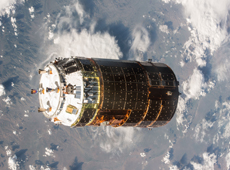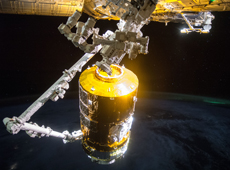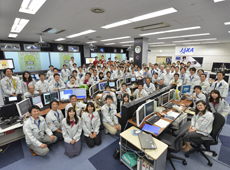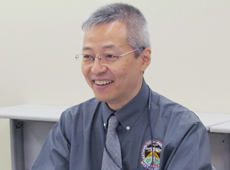
Improved Reliability with KOUNOTORI 5
— What aspects of KOUNOTORI 5’s operation stand out in your mind?
 KOUNOTORI 5 approaching the ISS (courtesy of JAXA/NASA)
KOUNOTORI 5 approaching the ISS (courtesy of JAXA/NASA)
 KOUNOTORI 5 captured by the robotic arm (courtesy of JAXA/NASA)
KOUNOTORI 5 captured by the robotic arm (courtesy of JAXA/NASA)
Three things stand out. The first was the moment when KOUNOTORI was successfully inserted into Earth orbit. On the day of the launch, August 19, 2015, I was on console as Flight Director in the Mission Control Room at the Tsukuba Space Center. My responsibility up to that point was establishing and monitoring KOUNOTORI’s attitude, once it was inserted into orbit after separating from the H-IIB rocket. Although I was putting up a calm front, I was actually quite nervous, because four months earlier the Russian cargo ship Progress had been lost at the same stage in its flight. I couldn’t get the images of Progress spinning completely out of control out of my mind, and even though I was completely confident that we would succeed, my heart was still pounding.
The second thing was the images of JAXA astronaut Kimiya Yui capturing KOUNOTORI with the ISS’s robotic arm. Our job is to get KOUNOTORI within 10 meters of the bottom of the ISS; everything after that is up to the ISS crew member performing the capture. Through the monitor, I watched intently as the robotic arm slowly closed in on KOUNOTORI. This was the first time in six years that I had seen a capture in real time. On the KOUNOTORI 2, 3 and 4 missions, video couldn’t be sent to the ground because of the space station’s position in orbit, so you couldn’t watch it in real time. Seeing the capture end in success was very emotional.
The third thing was the delayed release from the ISS. Due to problems with the robotic arm, there was difficulty releasing KOUNOTORI from the ISS. So we had to try again after making another orbit. During the 90 minutes it takes to make a single orbit, we were busy changing the computer settings and doing the many other things that had to be done. But because we had trained so many times to handle problems such as this, we were able to react in a calm and collected manner. In fact, this was actually our first one-orbit delay in six years – since KOUNOTORI 1, when we needed to avoid space debris. But the team’s experience and skill level were entirely different back then. I have worked on flight control since KOUNOTORI 1 back in 2009, and this experience made me realize just how much the team has grown.
— Do you feel that NASA’s assessment of KOUNOTORI has changed since KOUNOTORI 1?
 Emergency cargo from NASA, arrived at Tanegashima Airport
Emergency cargo from NASA, arrived at Tanegashima Airport
As the degree of confidence in KOUNOTORI has grown, NASA has asked us to take on more and more highly critical cargo missions. These missions include essential supplies such as food, water and clothing, as well as experiments and other items. Because of the need to conduct a wide array of inspections and KOUNOTORI assembly after the cargo loading, we load the cargo about four months before launch. Cargo integration is another one of my jobs. As we determine the positioning and loading order of the cargo, we have to calculate the weight balance. Because we have to consider factors such as the center of gravity and launch direction, any change to the cargo before launch means we have to do those calculations all over again. This is why we try to avoid reloading cargo whenever possible.
Before the launch of KOUNOTORI 5, American and Russian cargo ships had failed in quick succession, leaving the ISS crew without their scheduled supply deliveries. As a result, NASA made an emergency request for us to add a number of items, including filters for the water reclaimers that clean the astronauts’ urine.
The KOUNOTORI program has a Late Access service that allows time-critical cargo to be loaded up until 80 hours before launch. This service is used when there’s a need to deliver items such as fresh food or biological specimens for use in bioscience experiments. In fact, KOUNOTORI has the largest capacity for Late Access cargo of any cargo ship currently in service, but there’s still very little room left over for new cargo. And although it was vital that these replacement filters reach the ISS because the astronauts had ran out, we still wanted to get the original cargo to the space station as planned.
After several days of meetings, we realized that we could do this by using the space in front of where the experiments are loaded, which is not usually used for cargo. By moving the lighter cargo there, we were able to make room for the emergency supplies. While it’s incredibly difficult to move the cargo around so close to the launch, we were able to fulfill NASA’s request, and I feel that this further increased their level of confidence in Japanese space technology.
Safety and punctuality: the key to gaining the confidence of others
— What is the key to gaining the confidence of international partners?
 KOUNOTORI 5 (courtesy of JAXA/NASA)
KOUNOTORI 5 (courtesy of JAXA/NASA)
The most important aspects to gaining the confidence of others is, first and foremost, safety, with punctuality being a close second. In order to avoid endangering the ISS crew, safely docking KOUNOTORI is paramount. Today the majority of cargo ships use the same method of rendezvousing with ISS – using the robotic arm – but KOUNOTORI was the first. At the time, we were going to use a method no one had tried before, and on top of that, Japan had never rendezvoused an unmanned cargo ship with a manned spacecraft before. So naturally, at first, NASA’s safety managers had no faith in our ability. To convince them, we calculated 8,000 different orbits taking every conceivable contingency into account. We then used computer simulations to show that KOUNOTORI posed absolutely no danger to the ISS no matter what happened.
While that did convince NASA, we were told it still wasn’t enough. They asked us to prove our calculations with results. So during KOUNOTORI 1, we were constantly collecting data on whether the flight was proceeding as simulated. We used this data to show NASA that the flight was proceeding safely, just like our analysis had predicted. That’s how important safety is.
Delivering the cargo on schedule is also important. That means there should be no problems during construction, even in the work on the rocket. We have a total of nine scheduled KOUNOTORI missions, and building them as part of a series is also one of the program’s strengths. We launched KOUNOTORI 5 last year, but the next vehicle, KOUNOTORI 6, was being constructed in parallel. So had there been a problem with one of KOUNOTORI 5’s components, we could have quickly swapped it with a part from KOUNOTORI 6. By proceeding systematically like this, we’ve been able to keep our delivery schedule on track. And as a result, KOUNOTORI has earned a strong reputation as a reliable ship that delivers its cargo on time.
— There was a two-year gap between the launch of KOUNOTORI 4 and KOUNOTORI 5. Was it hard to maintain the team’s motivation during that period?
 KOUNOTORI Mission Control Team
KOUNOTORI Mission Control Team
That’s a great question. To be completely honest, maintaining the team’s motivation was no simple task. But even then, I like to think of those two years as a chance to bring in new blood. There are around 80 people on the KOUNOTORI flight control team, but during that time we replaced about a quarter of the team, and because we had two years before the next launch, we were able to spend more time than usual on training. Before we did an actual mission, everyone on the team was able to gain the skills to cope with the unexpected. In terms of maintaining Japan’s technological advantage, I think that passing down techniques is vital. I am glad we were able to bring on so many new team members.
Continued Development of KOUNOTORI
— What are your plans for continuing to develop the technology originated for KOUNOTORI?
 Conceptual image of HTV-X
Conceptual image of HTV-X
We have a three-pillar plan for future development. First, we will continue to improve our technique for delivering cargo to the ISS. Although the ISS is scheduled to operate until 2024, we have plans for one KOUNOTORI launch per year until KOUNOTORI 9.
The second pillar is providing opportunities to perform experiments in orbit. KOUNOTORI 5 was equipped with the Kounotori Advanced SPace Environment Research equipment (KASPER), which was used to study electrification in space and demonstrate a technology for measuring space debris. In addition, there is a plan to electrify wires attached to debris in order to lower its altitude so that it burns up in the atmosphere. We plan to test this technique with KOUNOTORI 6. A single KOUNOTORI mission is 40-60 days long, so if the spacecraft is carrying the necessary equipment, we can use that time to conduct experiments and observations. We would like to find opportunities to do more with KOUNOTORI than simply carrying cargo.
The third pillar is the development of the next version of KOUNOTORI. We are going to build a new spacecraft by building upon the technology we have developed so far. Currently, JAXA is researching a compact recovery capsule that can return experimental samples to Earth, as well as HTV-X, which will be capable of future lunar and Martian exploration missions.
— What sort of spacecraft is HTV-X?
HTV-X aims to maintain and improve upon the cargo delivery technology of KOUNOTORI. The pressurized section of KOUNOTORI, where the experiment racks, water, and other ISS supplies are stored, can be used without any major changes, but we’re looking to alter the design of the shelving and increase the cargo capacity by 30%. At the same time, we will try to make it possible to carry larger items in the area used to hold extravehicular experiments.
While we will be repurposing the pressurized section of KOUNOTORI, one of the key features of HTV-X is that we’ll be able to change the other components depending on the mission objectives, making a wide array of missions possible, including recovering cargo from the ISS, or future lunar exploration missions. Design of the HTV-X started last year, and we are aiming to launch a Technical Demonstration Vehicle in 2021.
Contributing to international space exploration
— What do you think Japan’s strengths are?

I think the Japanese people excel at team play. Rather than there being a charismatic leader that pulls the team along, each of us understands his or her own role, and we all think very hard about what we can do for the team. Beyond that, the team is supported by Japan’s advanced technological abilities. No matter how good our teamwork is, we can’t succeed in our mission if KOUNOTORI doesn’t work as designed. I think the fact that we haven’t had any major issues with Kibo or KOUNOTORI shows that we possess world-class manned space technology.
— What do you think Japan’s role will be in future manned space flight?
I think Japan should further develop the technologies that it’s strongest in – for example, robotics. I think that with robots to support manned space flight, humans could do more things, more safely. Even if we eventually go to Mars, it would be safer to send robots ahead to build the base than to have humans build it when they arrive. We could send humans after we’ve confirmed the soundness of the base’s construction. In that sense, we can think of KOUNOTORI as a sort of robot that delivers supplies. I think Japan’s most important role is to continue to steadily develop its strongest fields and contribute to international space exploration with its top-notch technology.
— What are your goals for the future?
I’m the oldest of our active flight directors, so I feel that it is my purpose to develop the next generation. Looking toward future manned missions to the moon and Mars, I would like to train flight directors who have a wide range of knowledge. I personally feel that we should integrate the KOUNOTORI and Kibo flight control teams, which currently work separately. As I am also in charge of flight control for Kibo, I am keenly aware that while the Kibo team is great at operating facilities where people live, they are weak at flying spacecraft. The opposite is true for the KOUNOTORI team. However, when people go to the moon or Mars, they need the technology get them there, as well as the technology to live there. This is why I think we need people with the knowledge possessed by both the KOUNOTORI and Kibo teams. I would like to develop individuals capable of handling a variety of missions, while also improving my own skills as a flight director.
Dai Asoh

Flight Director, H-II Transfer Vehicle KOUNOTORI (HTV)
Manager, JEM/HTV operations and HTV Cargo Integration, JEM Mission Operations and Integration Center,
Human Spaceflight Technology Directorate, JAXA
Mr. Asoh assumed his current position after working in satellite tracking and control, development of control equipment, and development of the ISS Centrifuge (he was in charge of the Life Science Glovebox). He is currently in charge of flight control for Kibo and KOUNOTORI, as well as cargo loading for KOUNOTORI.
[ April 13, 2016 ]